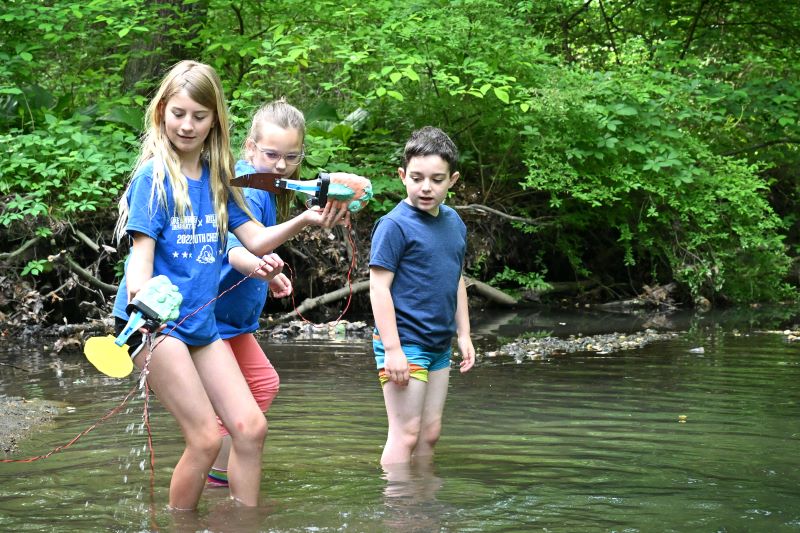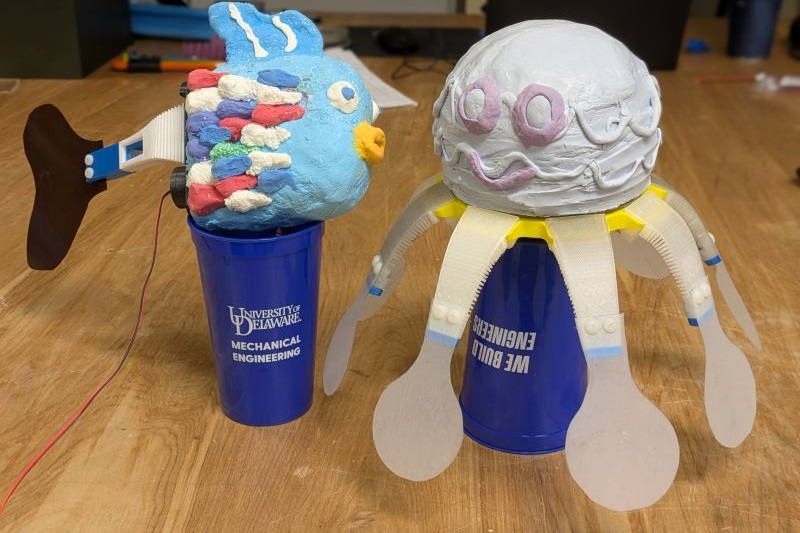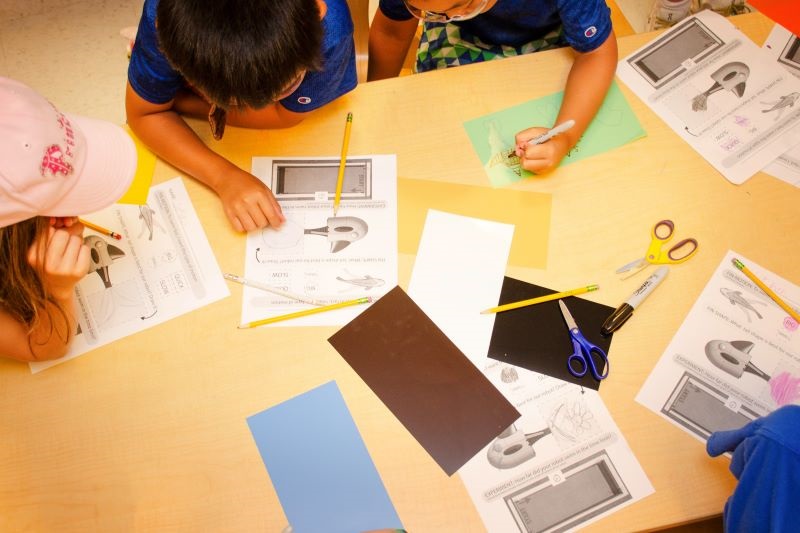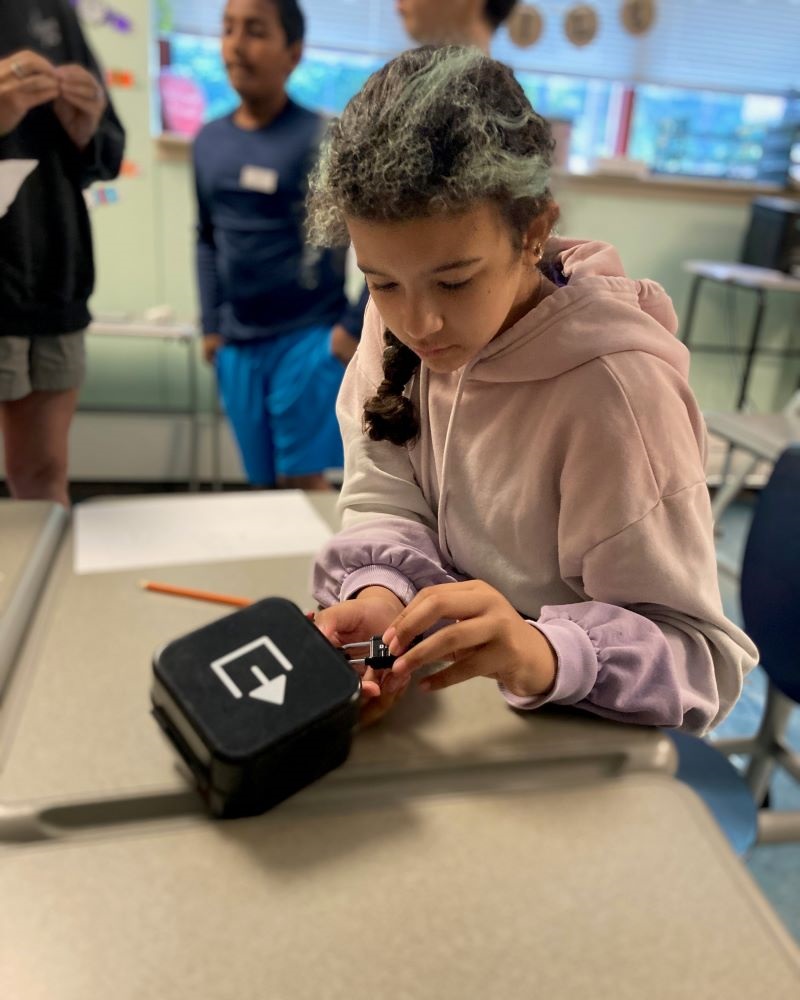Human Development and Family Sciences
Swimming with Sharks

Wading in the creek behind University of Delaware’s The College School, elementary students laughed and cheered as they met a challenge their teacher Laurie Drumm posed only a few months prior: build a robot that travels through water, mimics the characteristics of underwater animals and doesn’t scare the other fish. Through a new engineering curriculum, University of Delaware faculty from the College of Education and Human Development (CEHD) and the College of Engineering (COE) helped these students bring their robotic animals to life.
Supported by an Office of Naval Research Small Business Technology Transfer grant and developed in partnership with Spectral Energies, LLC, the Student-focused Holistic Aquatic Robotics Kit (SHARK) curriculum offers K-12 teachers a set of pre-designed robots that mimic the biology of aquatic animals with lesson plans that follow the Next Generation Science Standards. As students build and test a customizable shark, octopus or other swimmers in real underwater environments, they learn about the principles of engineering, physics, biomimicry and the needs of aquatic animals.
“SHARK helps provide a unique approach to how we think about mechanical design as we learn it when we are younger, particularly in grades K-12,” said Tyler Van Buren, assistant professor in COE’s Department of Mechanical Engineering and principal investigator. “Mechanical designs are pivoting from the rigid, wheels and bearings format and tend to be more biologically inspired, borrowing ideas from nature. SHARK could have easily been a toy design project for basic at-home entertainment, but partnering with CEHD faculty members Jennifer Gallo-Fox, Zoubeida Dagher and Laurie Drumm helped us elevate it to the classroom and reach targeted learning outcomes.”

Studying SHARK at The College School
Since January 2025, Drumm, master teacher at The College School and senior instructor in CEHD’s School of Education (SOE), has piloted the curriculum with her fourth and fifth-grade STEM classes. With the support of lesson plans developed by Gallo-Fox and Dagher, Drumm guided her students as they observed real-life fish, tested the material properties of artificial fish tails and measured the strength of the tails, among other activities.
“The curriculum allows students to be completely creative with their designs,” Van Buren said. “Students could make a rainbow fish, swordfish, sea turtle or a different aquatic animal. The tail shape, size and flexibility were completely up to them. And, they got a chance to design based on what worked best for swimming—what went faster or took less energy—instead of just what looked best.”
As students built their underwater robots, Gallo-Fox and Dagher studied how they engaged with the curriculum, documented their knowledge of engineering principles and worked to modify the lesson plans to meet their specific needs.

“In our study, we were curious about how the students interacted with the new curriculum: what questions they asked, which engineering practices they adopted and how they worked in teams to reconcile their ideas, identify solutions and test them out,” said Dagher, who specializes in elementary and middle school science education in the SOE. “Our team—which included engineering doctoral student Frank Tricouros and education graduate students Maisha Mouli and Faezeh Vahdat Nia—worked collaboratively to address technical issues and improve the design components, while also modifying the scope and sequence of the original lesson plans, guided by the children’s readiness to move to the next phase.”
While study results are still forthcoming, Drumm observed that the curriculum helped her students develop skills like collaboration and teamwork, problem-solving and critical thinking. Through its hands-on, iterative approach, she also noticed how the curriculum supported some of her students with communication. Though the curriculum may be used in any educational setting, The College School specializes in academic and social-emotional education for children with learning differences in grades 1 through 8.
“For some of our students with language-based learning differences, those who have a hard time communicating through reading and writing, the opportunity to build something and to do it numerous times—like building multiple drafts of the fishtails—really reinforced their learning,” Drumm said. “When they had something in their hands, these students had a tool they could use to explain what they were thinking to us. The activities were repetitive and scaffolded in a way that gave them that language support.”
Summer SHARK sightings
By the end of the school year, Drumm’s students begged her for more time with their robots, with some even asking to bring their robots home. By design, the UD team developed the curriculum to grow with students.

“We’ve developed three different designs that span different age ranges: pre-K to fifth grade, upper elementary-middle school and high school,” said Gallo-Fox, who specializes in early childhood and teacher education in CEHD’s Department of Human Development and Family Sciences. “The designs and curricular concepts get increasingly complex as they move up the grade levels with coding in the two kits for older students. We designed curricula for the development and learning expectations of different age groups, but the activities are open-ended so that children can interact with them in the ways that are most appropriate for their ability levels.”
The versatile curriculum can be used in home educational settings and robotics clubs as well. This summer, Drumm will use the curriculum in The College School’s robotics STEAM camp, one of the many summer camps for elementary school students offered between June 16 and August 22.
In July, underwater robotics will make its return to CEHD’s Early Learning Center (ELC), which serves children from the ages of 6 weeks through second grade. Through the ELC’s summer camps, kindergarten through second-grade students engage with the SHARK curriculum.
To learn more about CEHD research in STEM education, visit its research page.

Photos by Tyler Van Buren.
